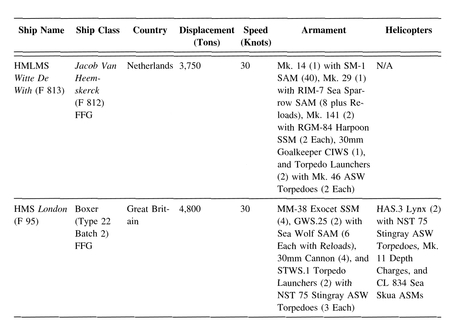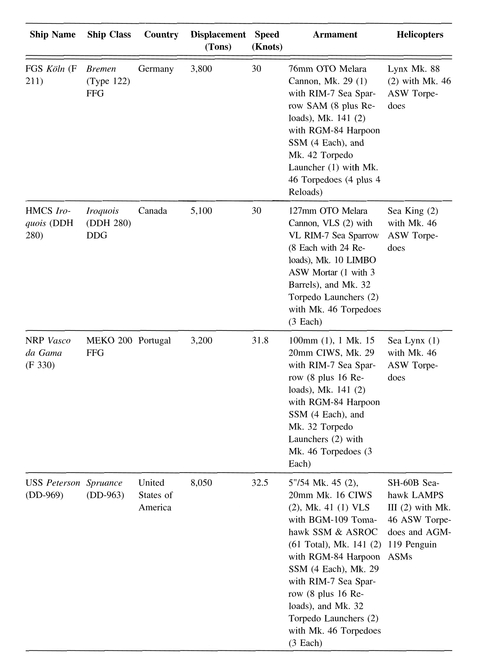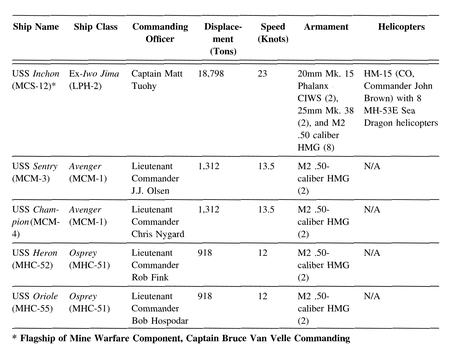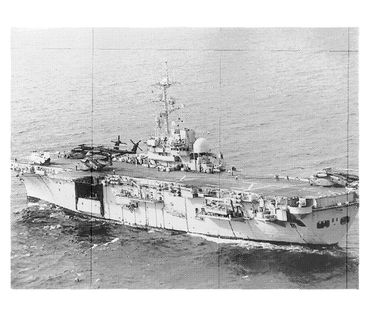Carrier (1999) (52 page)
Authors: Tom - Nf Clancy

For JTFEX 97-3 the opposing players would be known as Koronans, and the neutral victims of Koronan aggression would be Kartunans. Kartuna’s homeland would be the center of the scenario’s crisis. The Koronan forces would be played by various elements of the 2nd Marine Division at Camp Lejeune, North Carolina, 2nd Fleet at Norfolk, Virginia, and some Marine aviation units from the Marine Corps Air Stations at Cherry Point and New River, North Carolina and Beaufort, South Carolina.
While the simulated Koronan military would be nowhere as large as that of Iraq prior to the invasion of Kuwait in 1990, it would nevertheless have some distinct similarities. For example, Marine F/A-18 Hornet fighter/bombers from MCAS Beaufort would simulate Mirage F-1Cs armed with Exocet antishipping missiles and MiG-29 Fulcrums equipped with advanced air-to-air missiles (AAMs). Several
Spruance-
class (DD-963) destroyers and
Oliver Hazard
Perry
-class (FFG-7) frigates would simulate Russian
Kashin-
class missile destroyers and Chinese missile corvettes. Finally, Marines based at Camp Lejeune would play Kartunan ground units, while Lejeune itself would play the part of the Kartunan homeland.
Spruance-
class (DD-963) destroyers and
Oliver Hazard
Perry
-class (FFG-7) frigates would simulate Russian
Kashin-
class missile destroyers and Chinese missile corvettes. Finally, Marines based at Camp Lejeune would play Kartunan ground units, while Lejeune itself would play the part of the Kartunan homeland.
The forces of the Allied coalition would, of course, be played by the
GW
battle group and CVW-1, as well as their attached
Guam
ARG and the embarked 24th MEU (SOC). Though a battalion of the Army’s 82nd Airborne Division and a number of USAF KC-135 aerial tanker aircraft based at Langley AFB, Virginia, would also play, the focus of this particular exercise was naval and expeditionary. This meant that if combat units could not fly or float into the JTFEX 97-3 scenario, they would
not
participate.
GW
battle group and CVW-1, as well as their attached
Guam
ARG and the embarked 24th MEU (SOC). Though a battalion of the Army’s 82nd Airborne Division and a number of USAF KC-135 aerial tanker aircraft based at Langley AFB, Virginia, would also play, the focus of this particular exercise was naval and expeditionary. This meant that if combat units could not fly or float into the JTFEX 97-3 scenario, they would
not
participate.
One of the largest (and most interesting) of the participants was Standing Naval Force Atlantic (STANAFORLANT). STANAFORLANT, established in 1967, was the Cold War equivalent of a World War II Hunter-Killer (HUK) ASW group—but with a unique twist. Each NATO nation involved was to assign a destroyer or frigate from their Navy to STANAFORLANT, and then the total force was placed under a single joint NATO commander. This arrangement has the advantage of providing the STANAFORLANT commander with an eclectic mix of weapons and sensors, and with personnel whose training, talents, and experiences are widely varied. Ships from Canada, Germany, the Netherlands, the United Kingdom, and the United States of America form the permanent membership of STANAFORLANT (there are usually a half-dozen ships operating in it at any given time); but they are joined periodically by Naval units from Belgium, Denmark, Norway, and Portugal.
STANAFORLANT carries out a program of exercises, maneuvers, and port visits, and can be rapidly deployed to a threatened area in times of crisis or tension. Throughout the Cold War, STANAFORLANT provided a rapid-response escort group for NATO naval commanders, in case of a sudden “surge” by the submarine and naval forces of the former Soviet Union. Today, STANAFORLANT’s mission has broadened from this Cold War mission. Now STANAFORLANT is one of several NATO ready-reserve naval units that provide sea control services to the alliance (another of these units is in the Mediterranean supporting operations around Bosnia); and it could easily be found enforcing a maritime embargo or providing disaster/ humanitarian relief. During JTFEX 97-3, it would practice all of these missions, and some others that would have been hard to imagine as little as ten years ago.
While STANAFORLANT would not technically be part of the
GW
battle group, it would nevertheless be attached to it. Since ships constantly cycle in and out of STANAFORLANT, there is no such thing as a “standard” mix of ships and weapons. However, the STANAFORLANT group that participated in JTFEX 97-3 is representative. Let’s look at it:
GW
battle group, it would nevertheless be attached to it. Since ships constantly cycle in and out of STANAFORLANT, there is no such thing as a “standard” mix of ships and weapons. However, the STANAFORLANT group that participated in JTFEX 97-3 is representative. Let’s look at it:
STANAFORLANT Ships Participating in JTFEX 97-3


As you can see, the STANAFORLANT group assigned to participate in JTFEX 97-3 was a compact, powerful surface action group (SAG) that could bring a wide variety of weapons and systems to bear on a particular threat or mission.
For this exercise, the command of STANAFORLANT fell onto Rear Admiral Peter van der Graaf of the Netherlands, a tall blond bear of a sailor, who was based aboard his flagship, HMLMS
Witte De With
(F 813). With his vast smile and hearty laugh, Admiral van der Graaf quickly became a favorite of the
GW
battle group. In fact, he would hoist his flag aboard the
George Washington
at one point during the exercise. That he was a superb ship handler and leader only made STANAFORLANT’s presence in JTFEX 97-3 the more telling.
Witte De With
(F 813). With his vast smile and hearty laugh, Admiral van der Graaf quickly became a favorite of the
GW
battle group. In fact, he would hoist his flag aboard the
George Washington
at one point during the exercise. That he was a superb ship handler and leader only made STANAFORLANT’s presence in JTFEX 97-3 the more telling.
One other small, but useful, naval force took part in JTFEX 97-3: a special mine warfare component. This unit would test a number of new ships, systems, and technologies designed to counter what most professional Naval analysts agree are the single greatest threat to naval littoral operations. These deadly “weapons that wait” are extremely cost-effective. They are not only relatively cheap to make, but they don’t have to be high-tech to do the job. In fact, many current mines have basic technologies going back decades. At the same time, like their land-based counterparts, sea-based mines can make areas of ocean uninhabitable for years at a time. The fact that four of the five U.S. ships suffering combat damage in the last two decades have been hit by mines (the supertanker SS
Bridgeton,
frigate
Samuel B. Roberts
(FFG- 58), Aegis cruiser
Princeton
(CG-59), and helicopter carrier
Tripoli
(LPH- 10)) only highlights the threat. I should note that three of these ships were damaged by mines whose Russian design actually predates the First World War.
Bridgeton,
frigate
Samuel B. Roberts
(FFG- 58), Aegis cruiser
Princeton
(CG-59), and helicopter carrier
Tripoli
(LPH- 10)) only highlights the threat. I should note that three of these ships were damaged by mines whose Russian design actually predates the First World War.
Despite the obvious threat presented by mines, over the last two decades mine warfare has been allocated less than one percent of the USN budget. The problem: Mine warfare is not glamorous. Compared with commanding a sleek destroyer or submarine, or flying a combat aircraft, it is considered decidedly “un-sexy” by most naval professionals. Much like infantry combat in urban areas, it is a nasty, dangerous business. Clearing mines takes a lot of time, it’s filled with headaches, it generates casualties, and failure is easy to come by—not a smart career move. All the same, if the U.S. sea services are to become a littoral-capable force, mine warfare will have to become an equal partner with surface, subsurface, and air components of the fleet. The Navy has been taking serious action to make this intention a reality.
For JTFEX 97-3, a “rainbow” mine warfare force of ships, helicopters, and personnel was assembled from units along the coast of the Gulf of Mexico. These units represent the state-of-the-art of USN mine warfare technology and doctrine. Under the command of Captain Bruce Van Velle (who would act as the unit’s Commodore and the mine warfare component commander), the unit was composed of the units shown below:
JTFEX 97-3 Mine Warfare Task Force

JTFEX 97-3 was the first occasion that the Navy’s new emphasis on mine warfare was included in a major Atlantic Fleet joint exercise. The core of the mine warfare component was the converted helicopter carrier
Inchon
(MCS-12). Designed to act as a command ship for the mine countermeasures force of mine-hunting helicopters and minesweepers, the
Inchon
is the largest, most capable ship to ever take on this task. For JTFEX 97-3, she would act as a mobile air base for eight RH-53E Sea Dragon mine-countermeasures helicopters and four hundred personnel from Mine Countermeasures Squadron Fifteen (HM-15, the “Blackhawks”). Based at Moffet Field near Sunnyvale, California, and commanded by Commander John Brown, the Blackhawks are a mix of active and reserve personnel who fly one of the most interesting aircraft in the Navy inventory. Their MH-53E Sea Dragon, a modified version of the Marine CH-53 Super Stallion heavy transport, tows mine-countermeasures “sleds” and other equipment from a few hundred feet above the sea, and is one of the most effective means of clearing lanes through mine-infested shallow waters. Looking much like their Marine CH- 53E brethren, the Sea Dragon is easily distinguishable by the large side sponsons filled with extra fuel, which the MH-53E guzzles at low altitude.
Inchon
(MCS-12). Designed to act as a command ship for the mine countermeasures force of mine-hunting helicopters and minesweepers, the
Inchon
is the largest, most capable ship to ever take on this task. For JTFEX 97-3, she would act as a mobile air base for eight RH-53E Sea Dragon mine-countermeasures helicopters and four hundred personnel from Mine Countermeasures Squadron Fifteen (HM-15, the “Blackhawks”). Based at Moffet Field near Sunnyvale, California, and commanded by Commander John Brown, the Blackhawks are a mix of active and reserve personnel who fly one of the most interesting aircraft in the Navy inventory. Their MH-53E Sea Dragon, a modified version of the Marine CH-53 Super Stallion heavy transport, tows mine-countermeasures “sleds” and other equipment from a few hundred feet above the sea, and is one of the most effective means of clearing lanes through mine-infested shallow waters. Looking much like their Marine CH- 53E brethren, the Sea Dragon is easily distinguishable by the large side sponsons filled with extra fuel, which the MH-53E guzzles at low altitude.
Along with the
Inchon
and her mine-countermeasures helicopters, four new
Avenger
(MCM-1) and
Osprey-
class (MHC-51) mine-hunters with their reserve crews would participate in the exercise in order to demonstrate new ideas and technologies. These included an autonomous mine-detection vehicle, along with an explosive mine-clearing system to clear lanes for landing craft in the surf zone of an invasion beach. This increased emphasis on mine warfare is long overdue, and the efforts being pursued during JTFEX 97-3 are just the first of what will be many badly needed steps.
Inchon
and her mine-countermeasures helicopters, four new
Avenger
(MCM-1) and
Osprey-
class (MHC-51) mine-hunters with their reserve crews would participate in the exercise in order to demonstrate new ideas and technologies. These included an autonomous mine-detection vehicle, along with an explosive mine-clearing system to clear lanes for landing craft in the surf zone of an invasion beach. This increased emphasis on mine warfare is long overdue, and the efforts being pursued during JTFEX 97-3 are just the first of what will be many badly needed steps.
RH-53E Sea Dragon helicopters of HM-15 aboard the flagship of the Mine Countermeasures Task Force during JTFEX 97-3, the USS
Inchon
(MCS-12).
Inchon
(MCS-12).
OFFICAL U.S. NAVY PHOTO

JTFEX 97-3 was under the control of the 2nd Fleet commander, Admiral Paul Reason, who would watch over the exercise from the fleet flagship, the USS
Mount Whitney
(LCC-20). Aboard the
Mount Whitney
would be the various warfare component commanders (air, naval, ground, special operations, etc.) that would run JTFEX 97-3, as well as many of the exercise observation personnel. JTFEXs and other large-scale exercises require significant numbers of people to manage and record what is going on. Thus, JTFEX 97-3 required the efforts of several thousand military and civilian personnel to observe, document, and analyze all that went on over the millions of cubic miles of battlespace off the Atlantic coast. These included observation teams from the Center for Naval Analysis (CNA—a U.S. Navy-funded “think tank”) and members of the Senior Officers Observer Team (SOOT). The SOOT team is made up of ship, squadron, and other commanders who are temporarily detached from their own commands and assigned to observe and evaluate the actions of their counterparts.
Mount Whitney
(LCC-20). Aboard the
Mount Whitney
would be the various warfare component commanders (air, naval, ground, special operations, etc.) that would run JTFEX 97-3, as well as many of the exercise observation personnel. JTFEXs and other large-scale exercises require significant numbers of people to manage and record what is going on. Thus, JTFEX 97-3 required the efforts of several thousand military and civilian personnel to observe, document, and analyze all that went on over the millions of cubic miles of battlespace off the Atlantic coast. These included observation teams from the Center for Naval Analysis (CNA—a U.S. Navy-funded “think tank”) and members of the Senior Officers Observer Team (SOOT). The SOOT team is made up of ship, squadron, and other commanders who are temporarily detached from their own commands and assigned to observe and evaluate the actions of their counterparts.
It was against this backdrop of objectives, plans, technologies, ships, aircraft, and personnel that John Gresham (my researcher for this series) and I traveled south to the Virginia Tidewater to take in the events of JTFEX 97-3 in late August and early September 1997—almost three weeks. Partly because space doesn’t permit, but even more because much of what I saw concerned operationally sensitive issues, I cannot begin to tell you about all of what went on there. Nevertheless, I’ll show you some of the high points, as well as some of what life is like aboard U.S. warships.
Other books
I Dreamed I Married Perry Mason by Susan Kandel
A Wizard of Mars, New Millennium Edition by Diane Duane
The Annihilation Score by Charles Stross
Love and War: The Coltrane Saga, Book 1 by Patricia Hagan
Deep Sea by Annika Thor
Orchard of Hope by Ann H. Gabhart
Burned by Abi (Devil Savages MC Book 2) by Harley McRide
Return to Harmony by Janette Oke
Throne of Scars by Alaric Longward
Repairman Jack [07]-Gateways by F. Paul Wilson
